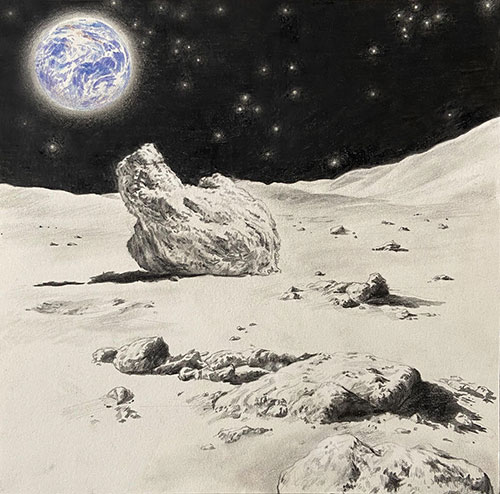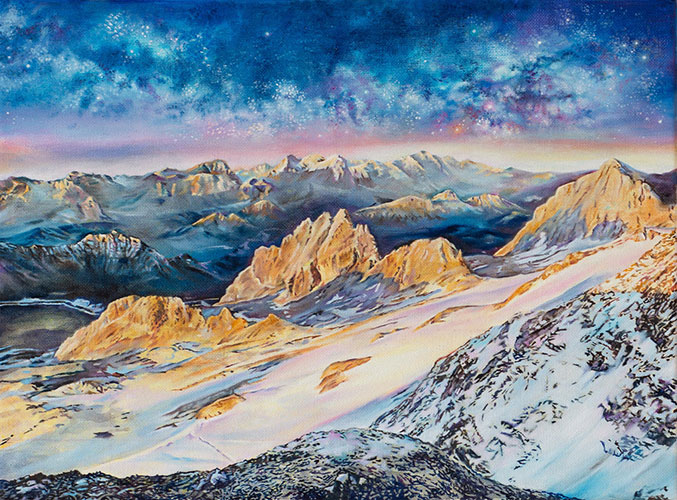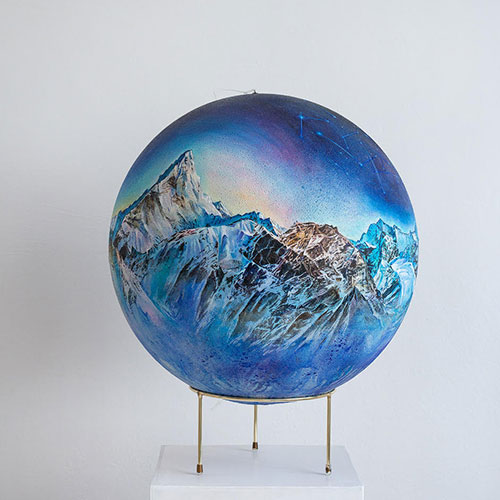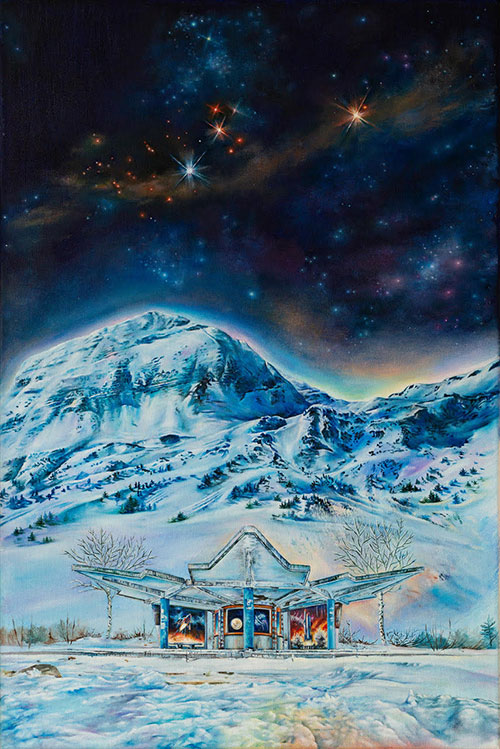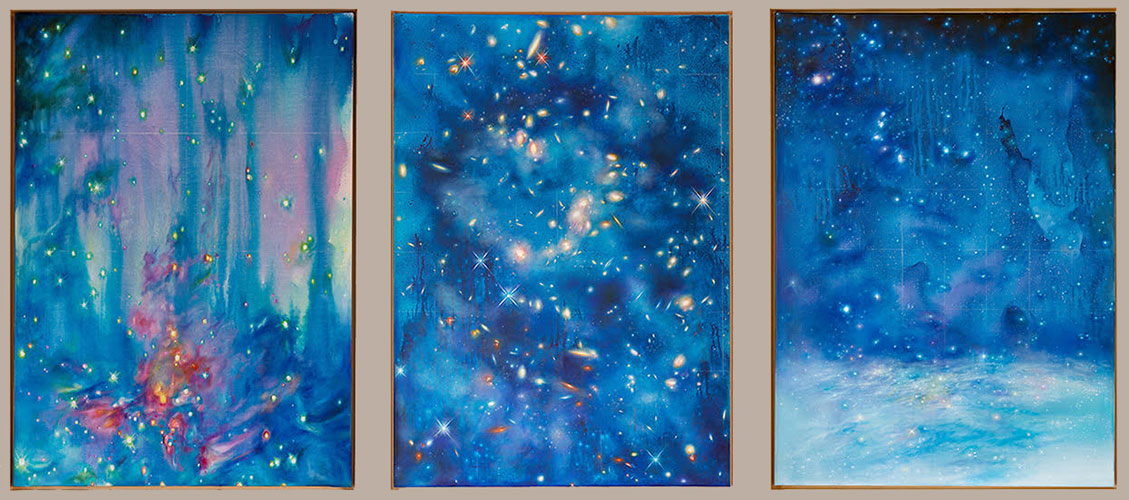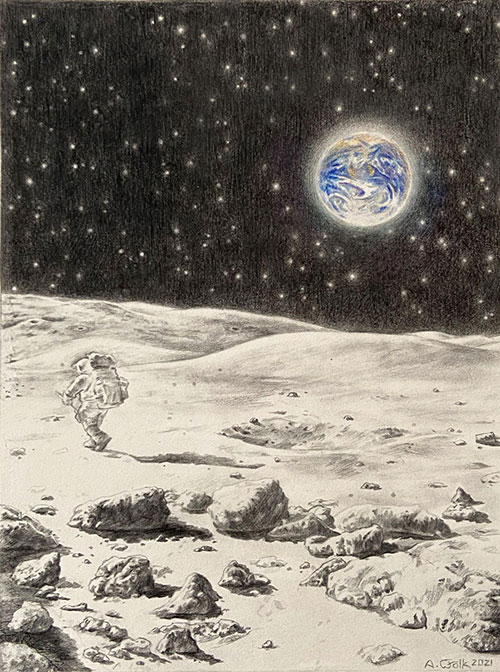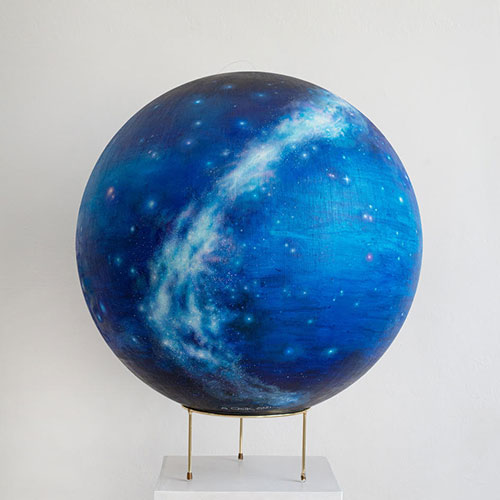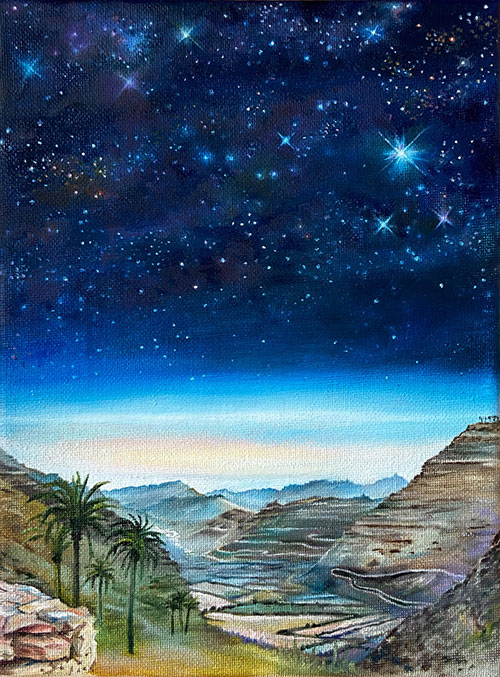Art, // December 20, 2021
Anne Wölk — ARTIST
Interview with artist Anne Wölk —
1. Who are you and what do you do?
My name is Anne Wölk. I was born in 1982 and raised in former East Germany, in a city named Jena. I create figurative and landscape paintings using traditional methods and scientific imagery to depict a surreal galactic space and sketch a futuristic vision. My work is inspired by Romanticism and Utopia and stands in the tradition of realistic contemporary artists Vija Celmins and Russel Crotty. By layering content from these diverse sources, I create a fantastical interpretation of nature. Working on a finely nuanced palette of blue shades enables me to translate glow and shine into a visual language.
2. Why art?
Art carries this paradox that it can make you dream of the unreal as well as give you a clear vision of reality. The galaxies, skies or surreal worlds I depict are supposed to bring a dream while contemplating a detailed reality. The planetarium in my hometown of Jena was one of the rare places where dreaming about travelling was allowed. By attending countless simulations of stellar skies in the planetarium, a place conceived as a walk-in celestial globe, I experienced the highly enveloping experience of an artificial starry sky at an early age. Art can generate the same experience. My enthusiasm for astronomy and space travel awoke at this place and continues in my work today.
3. What is your earliest memory of wanting to be an artist?
Being an artist was valued in my family and this came naturally as I was growing up, so my earliest memory goes back to when I was just a little girl. I did colour pencil drawings with my grandfather, who was excellent at drawing men’s heads. He was very knowledgeable about the East’s landscapes, with its birch trees and the Baltic region’s coastal formations. While living in East Germany, I regularly studied artworks from Polish landscape painters. I still love the paintings Moose Fighting with Wolves by Julian Fałat (1853–1929), The Old Town Square in Warsaw at Night 1892 by Józef Pankiewicz (1866–1940), and Courtship by Wacław Szymanowski (1859–1930).
4. What are your favorite subject(s) and media(s)?
My paintings predominantly show night sky sceneries with deep and open galaxies. By quoting space telescope images and digital photography resources, I test the margins between art and reality. My depictions attempt to close the photographic information gaps, like digital error glitches. Simultaneously, I sample landscape compositions in a collage technique to envision a possible future. The aim is to present discoveries that the audience might have missed. For instance, I replace the deep light of the old masters with screen colours from backlit screen surfaces and attempt to carry the classic themes of the landscapes into the present and future.
5. How do you work and approach your subject?
I approach painting in a constructive way that aims to create atmospheres and universes. By working with the method of collaging and sampling, a reinvent the scientific reality and establish a vision for the future. In my studio I work with one assistant who helps me to put into practice more extensive projects and track of each piece’s progress. For more exceptional projects, sometimes friends help me with technical advice.
6. What are your favorite art work(s), artist(s)?
Some of my favorite artists are Vija Celmins, Russel Crotty, Angela Bulloch, who inspire my work on an important level. Celmins’s East-European roots and aesthetics resonate with me and my way of seeing and sensing art, especially when focusing on astronomy. Many international futuristic and utopian novels influence my painting motifs and artistic research, such as Return from the Stars by Stanisław Lem and Roadside Picnic by the brothers Arkady and Boris Strugatsky. The artists of today are also a great source of inspiration. I have two drawings by my Dutch colleague, Witte Wartena, and four paintings from my dear friend, Mitja Ficko, from Slovenia.
7. What are the best responses you have had to your work?
I would say when viewers are taken away by contemplation and nearly lose track of time. The colour spectrum of the light in my paintings aim to astonish viewers and take them away to a world of romance and silence. Just like a visual time-travel into another spatial reality.
8. What do you like about your work?
That I can bring a new way of dreaming to the world and that sometimes I feel like a scientist working to discover new planets and interstellar elements. In my most recent work, I was inspired by Nebulae, interstellar clouds formed of dust, hydrogen, and helium. The paintings exploring this particular cloud will be featured in my next solo exhibition entitled “Momentum in Space”, at the Pantocrator Gallery in Berlin.
9. What advice would you give to other artists?
My best advice is to be perseverant, to invest time, money, and effort into your career. It is also essential to travel and educate yourself. Putting yourself into situations to go out of your comfort zone and expose yourself to different cultures helps to realise how diverse the world truly is. Finally, having a website and sharing your art in the right places with the public is what gives life to your creations.
10. Where do you see yourself in 5-10 years?
My vision is to keep creating vibrant artworks with astonishing visions to spark joy and lead people into a dreamy contemplation. As a creative person, full of energy and love, sharing my passion with others feeds my heart. In 2019, my two-year goal was to produce enough consistent work to fill a new solo exhibition. This is now the case with my upcoming presentation at the Pantocrator Gallery. In my envisioned future, I want to take part in museum-quality shows in international institutions. On a larger scale, I hope my art brings beauty to the world and shows how magnificent nature is.
ABOUT THE ARTIST
Anne Wölk (1982, Jena/Germany) was born and raised in former East Germany. She is a figurative painter whose artistic work stands in the tradition of realistic contemporary artists Vija Celmins and Russel Crotty. Committed to an attitude of reskilling, Wölk uses traditional methods and materials. Her paintings predominantly show us night sky scenes with deep and open galaxies. By quoting Spacetelescope images and digital photography resources, Anne Wölk tests the margins between art and reality. In 2006, the young artist entered the international art world at the Contemporary Istanbul Art Fair, when the collector Can Elgiz bought one of her large-scale paintings for the Elgiz Museum of Contemporary Art in Istanbul. Her painting Doggirl was shown in several thematic group exhibitions next to famous artists Cindy Sherman, Tracy Emin, and Sarah Morris. After graduating from art school in 2009, the painter became known for beautiful large-scale landscape paintings and was selected and shortlisted for several international competitions and scholarships. Wölk currently lives and works in Berlin.
LINKS —
Website: https://annewoelk.com
Artitious: https://artitious.com/artist/anne-wolk/
SINGULART: https://www.singulart.com/de/künstler/anne-wölk-20745
Pantocrator Gallery: https://www.pantocratorgallery.com/current-exhibition
Facebook: https://www.facebook.com/AnneWoelkofficial/
Instagram: https://www.instagram.com/studio_anne_woelk/
Artfacts: https://artfacts.net/artist/anne-woelk/135041/artworks
kunstaspekte: https://kunstaspekte.art/person/anne-wolk





